On this clear, yet curiously balmy morning, 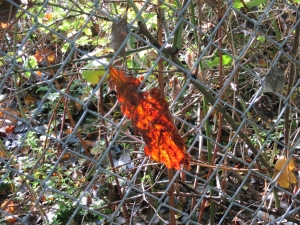 I walked along the footpath linking the Morden railway path to Lower Morden Lane, turning right into Cannon Hill Lane which meandered a bit before passing the common. Right again into Martin Way and I was soon home in Links Avenue.
I walked along the footpath linking the Morden railway path to Lower Morden Lane, turning right into Cannon Hill Lane which meandered a bit before passing the common. Right again into Martin Way and I was soon home in Links Avenue.
 In the wasteland at the back of Hillcross Avenue an optimistic individual had discarded a spotted umbrella. I noticed it.
In the wasteland at the back of Hillcross Avenue an optimistic individual had discarded a spotted umbrella. I noticed it.
On Grand Drive I was able to resolve to my satisfaction the significance of the white pavement markings mentioned yesterday.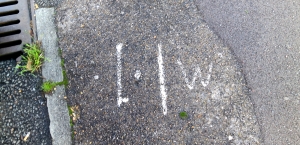 A helpful initial by a similar sign suggested water. Two workmen were amused by my activity, so I explained what I was doing. ‘Take a picture of him. He’s interesting’, said one. ‘Don’t take a picture of me’, retorted his companion. This was all in good humour, so as I turned away, I twisted around and pretended to photograph the man. Loud laughter all round.
A helpful initial by a similar sign suggested water. Two workmen were amused by my activity, so I explained what I was doing. ‘Take a picture of him. He’s interesting’, said one. ‘Don’t take a picture of me’, retorted his companion. This was all in good humour, so as I turned away, I twisted around and pretended to photograph the man. Loud laughter all round. 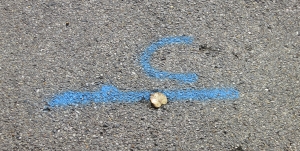 Further on, in Hillcross Avenue, I spotted initials by blue markings, C.P.U. One of these marks just bore C. Both Google and Chambers Dictionary give C.P.U. as central processing unit, so I am none the wiser.
Further on, in Hillcross Avenue, I spotted initials by blue markings, C.P.U. One of these marks just bore C. Both Google and Chambers Dictionary give C.P.U. as central processing unit, so I am none the wiser.
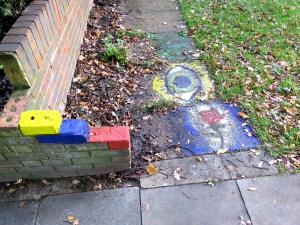 Opposite the common in Cannon Hill Lane someone had attempted to brighten up the footpath leading to their front door.
Opposite the common in Cannon Hill Lane someone had attempted to brighten up the footpath leading to their front door.
Not far from the Beverley roundabout, in Grand Drive, lies a First Holy Communion shop. Its display reminded me of my own exciting day, when I still believed in transubstantiation. As I knelt in my pew with my ‘shining morning face’ well polished, alongside all the other hopeful seven-year-olds, I eagerly awaited, with a certain amount of awe, my inauguration into this magical mystery tour. The essence of this tenet of Catholic belief is that, in taking communion, we are ingesting the real presence of Christ. The bread and wine are transformed into His body and blood, only retaining their outward appearance. Protestants believe this is simply symbolic.
Now, as I was preparing to leave for this morning’s ramble, I had spotted a fresh-faced young couple walking up to the front door of 34-40 Links Avenue. They stood outside and eventually rang our bell. Having realised what they were about, I went down to meet them. The young woman, who, on this occasion, was the spokesperson, began with the question: ‘Do you think that war and suffering will never end?’. Being familiar with this opening gambit, and noticing an index finger poised at the ready inside a copy of the Bible, I asked if they were Jehovah’s Witnesses. They were. I explained that I wasn’t interested, that I was a lapsed Catholic and therefore very familiar with the New Testament, and had, in recent years begun to explore the Old. ‘So you believe in the Bible’, she replied, grasping the straw. ‘I do’, said I, ‘but I don’t take it as literally as some people.’ I was grateful to Catholicism because it had given me principles to live by, although I no longer adhered to the religion. The man thanked me for answering the door. I said I had seen them come up the path and knew that they would ring all the bells in turn and eventually come to me. This was both delivered and received with humour.
I was prepared to enter into this discussion to some limited extent because I respect what they are doing. To my mind, whatever anyone’s faith, if truly believed, with consideration for others, and doing no harm, it can only enhance life. That is why I have no problem with Islam, especially as its adherents have done so much to lift Morden out of the doldrums. In the immediate aftermath of the 7th July 2005 London suicide bombings, two young Muslim men set up a stall on Oxford Street offering explanatory literature about their beliefs. I stopped and commended their courage, although I declined their material. Throughout the centuries and into modern times fanatics of all creeds have used religion to mask their true motives for causing mayem.
I have, in my time, chaired one fostering and two adoption panels. I had to temper the approaches of one or two members who were so anti-fundamentalism that they were suspicious of any different religions. What was important to me was what applicants’ beliefs meant to them and how they would affect their practical and emotional child care. The blood transfusion issue was sometimes, of course, an insurmountable problem.
When Jackie came home from work she showed me a copy of the Bhagavad Gita which had been given to her by a colleague. 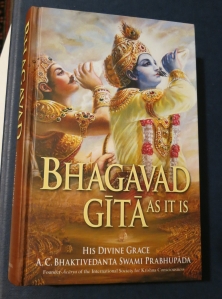 This is described as ‘an ancient text that…….provides disciplines that allow one to experience God in all things’. She could not have known how today’s theme had developed.
This is described as ‘an ancient text that…….provides disciplines that allow one to experience God in all things’. She could not have known how today’s theme had developed.
I had laid out the ingredients and begun to fry onions for a pasta sauce, when Jackie arrived and took over. This for me, was ‘a double result’. I did not have to cook and the sauce was, with the addition of chillies, turned into an arrabbiata. I am always tentative with these fiery ingredients, as I like them much hotter than anyone else. It seems more politic to simply leave them out. The delicious meal was consumed with Hoegaarden by Jackie, and Mondelli chianti 2009 by me.

One comment